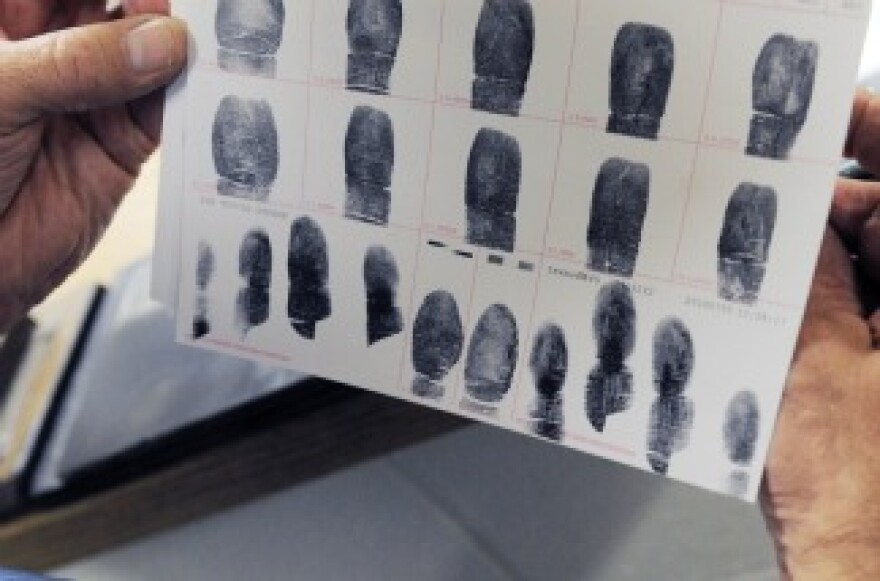With our free press under threat and federal funding for public media gone, your support matters more than ever. Help keep the LAist newsroom strong, become a monthly member or increase your support today.
Secure Communities: California sheriffs split over illegal immigration deportation program

Over the past few months, sheriffs in California have begun participating in a federal program known as Secure Communities. It requires them to share jail inmate fingerprints with immigration officials. Anyone in the country illegally is targeted for deportation. Sheriffs in Southern California support Secure Communities, but not the sheriff of San Francisco. In the second report in a two-part series, we examine the split.
Under Secure Communities, fingerprint data on everyone arrested is sent to a statewide database and then shared with federal officials. John Morton, the director of Immigration and Customs Enforcement, or ICE, says illegal immigrants are removed and put on a pathway to deportation.
"Many of the individuals that we identify through Secure Communities are not only here unlawfully for a first time," he says, "they are here unlawfully for a second or third time. They’d previously been deported. They’ve re-entered the country unlawfully. They’ve committed an offense for which they’ve been arrested now and we’ve come across them and this is their second or third time in the United States."
Los Angeles County Sheriff Lee Baca supports Secure Communities. He compares it to another collaboration with ICE called 287g, which trains deputies to identify possible undocumented inmates.
The sheriff says 287g has identified 20,000 criminal illegal immigrants in L.A. County over the past five years. Baca says 287g works because it focuses on criminal activity first.
"They have to be not only arrested for behavior, not ethnicity, or not status, and then the crime itself results in a trial and then a conviction," says Baca. "After the conviction, they have to serve their time. And it’s at that point they are entered into the system."
“Entered into the system” means giving details about a criminal’s immigration status to federal authorities, who then start deportation proceedings. Orange, San Bernardino and Riverside county sheriffs all adopted the 287g program and have now embraced fingerprint sharing under Secure Communities.
But ACLU staff attorney Jenny Pasquarella says Secure Communities is fundamentally different from 287g. "Creating a program whereby a person’s fingerprints are shared with immigration at the time of booking means that you’re identifying people far before you know that they’re actually a criminal or have done anything wrong."
San Francisco Sheriff Mike Hennessey says he's cooperated with ICE in the past, sharing information about those convicted of felonies. But in an interview with KQED, he says Secure Communities sweeps up anyone arrested.
"When you get local cops involved in enforcing immigration," he says, "it interferes with the trust that they have with the immigrant communities that they serve, it leads to people not reporting crimes, it leads to people refusing to be witnesses because they’re afraid they’re going to be deported if they go talk to the local cops."
Hennessey says he discovered it was impossible to simply "opt out" of the Secure Communities program. So instead, he says he’ll release low-level offenders rather than let immigration officials take them away.
The Santa Clara County Board of Supervisors voted to opt out of the Secure Communities program. But it’s not clear how the county can do that short of refusing to share any information on the people it has in jail with any other law enforcement agency.
So why are some Northern California counties upset with Secure Communities while Southern California sheriffs don’t mind? Fernando Guerra, director of the Center for the Study of Los Angeles at Loyola Marymount University says it’s partly ideology. The San Francisco Bay area leans more to the left than folks in Southern California.
But Guerra says it’s also demographics. "They have a lot less undocumented immigrants in Northern California and so they’re not impacted by the reality to the same degree as they are in Southern California."
Here’s Southern California’s reality: over the past five years, ICE has removed four times as many undocumented immigrants from jails in L.A. County as from those in San Francisco. According to the L.A. County Sheriff's Department, for every $10 it spends to lock up those immigrants, L.A. County gets less than $1.50 back from the federal government.
Even with that reimbursement, L.A. County still spends more than $100 million to incarcerate undocumented immigrants. Under Secure Communities, they’d become the responsibility of the federal government much sooner – and that could save L.A. County millions of dollars.







